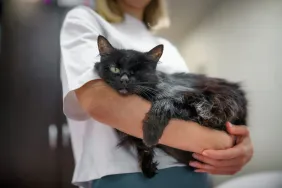Excess blood cells in the eye in cats is a condition that is caused by inflammation or abnormal lipid levels. The condition can affect a cat’s vision.
Technically, the condition refers to two separate conditions called hypopyon in cats and lipid flare in cats.
Generally, early detection is key to treating this condition.
Also, note that the condition is different from blood in the front of the eye in cats. That condition is also known as hyphema in cats. You can read more about it here.
If you see the signs of excess blood cells in the eye in your cat, then get to a veterinarian for a proper diagnosis and treatment.
Here’s what you should know about the symptoms, causes, and treatments for the condition.
Symptoms of Excess Blood Cells in the Eye in Cats
The condition produces a pretty wide range of symptoms. For example, some of the most common symptoms include:
- Swollen cornea
- Swollen iris
- Eyes looking cloudy
- Tearing
- Eye pain
- Twitching
- Bloodshot eyes
- Lesions
- Vision problems
- Inner eyelid protruding
Causes of Excess Blood Cells in the Eye in Cats

The cause of the condition is often an underlying condition. For instance, some of the common causes include:
- Uveitis
- Hyperlipidemia
- Eye tumors
- Toxoplasmosis
- Feline leukemia virus (FeLV)
- Bacterial infections
- Hypertension
- Feline immunodeficiency virus (FIV)
- Fungal infections
Treatments for Excess Blood Cells in the Eye in Cats
Firstly, your vet will ask about your cat’s symptoms. Secondly, your vet will ask about your cat’s full medical history. This will include any incidents that could have caused the condition.
Thirdly, a full physical examination and a detailed eye examination will be carried out. Blood and urine tests will also be taken. Additionally, any fluids from the eye will be analyzed.
Generally, treatment will depend on the precise cause of the condition. For example, in some cases, switching diet can help. Usually, a low fat and low calorie diet can help.
Alternatively, in other cases, anti-inflammatory medication can be prescribed. As always, if your vet prescribes your cat any medicine, make sure to stick to the correct dose and frequency instructions. Also, complete the full course of medicine.
Generally, the condition requires regular vet visits to make sure that it is not returning. Your vet can help suggest a safe schedule for your cat.
Have you ever cared for a cat who suffered from this condition? How did your vet help your kitty recover? Let us know in the comments section below.









